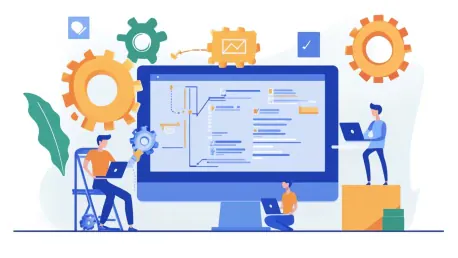Today’s rapidly evolving software landscape has made testing more critical than ever. Traditional testing, often considered a daunting task, is now being revolutionized by Generative AI (GenAI). Unlike the past where testing was a purely manual and specialized activity, GenAI is making software testing flexible, efficient, and accessible to a broader range of professionals.
The Complexity of Modern Software Development
Changing Dynamics
Over the last quarter-century, the software development environment has radically changed. Moving from infrequent changes and minimal integrations to a world with thousands of interconnected applications and complex dependencies, its evolution has been remarkable. This ongoing complexity of software ecosystems heightens the need for rigorous testing. Factors such as Infrastructure as Code (IaC) and potential supply chain threats make it essential to ensure that a single overlooked line of code does not have significant ripple effects. With applications increasing in both number and dependency, vigilant and methodical testing practices are more crucial than ever before.
Generative AI was initially anticipated to accelerate the development process; however, it brought along a set of new challenges, including code hallucinations and inefficiencies. These unexpected complications underscored the importance of robust and reliable testing mechanisms. Despite the advancements in development technologies, testing has emerged as a significant bottleneck in software modernization. The necessity for precise, scalable, and automated testing solutions became evident as developers faced new kinds of obstacles introduced by GenAI.
Testing Bottlenecks
The challenges brought about by the advancements in GenAI emphasized the need for improved testing methods. The inefficiencies and inaccuracies, commonly referred to as code hallucinations, became apparent as software systems grew in complexity. Recognizing this, companies started to explore innovative testing approaches to ensure the seamless integration and functioning of new code. The introduction of faulty or biased code had the potential to severely impact overall software operations, driving the push for more dependable testing methods.
Tricentis, renowned for its AI-powered testing solutions, came to the forefront in addressing these challenges. Their tools, such as Tosca and Testim, have become integral to modern DevOps teams, offering a range of solutions to navigate the intricacies of today’s software development. These tools leverage GenAI-augmented, model-based, and codeless testing methodologies. Through this sophistication, they ensure that any change within the applications is automatically propagated to numerous automated test cases, enhancing both reliability and efficiency in the testing process.
Innovative Approaches to Testing
Tricentis’s AI-Powered Solutions
Tricentis has pioneered several advancements in testing methodologies to address the evolving needs of software developers. Their AI-powered tools like Tosca and Testim offer enterprises the ability to manage the complexities of modern software testing more effectively. These solutions stand out by leveraging GenAI-augmented, model-based, and codeless testing methodologies. They ensure that any changes within applications are automatically propagated across countless automated test cases, thereby simplifying and streamlining the testing process. This approach not only reduces the manual effort involved but also ensures that the tests are always up-to-date with the latest code changes.
Tricentis’s tools are designed to integrate seamlessly into the development lifecycle, providing continuous testing capabilities. This means that testing is carried out in real-time, alongside the development process, ensuring immediate identification and rectification of issues. By using model-based testing, these tools start with the business model rather than the code itself, mirroring the concept of autonomous cars in test management. This innovative approach makes testing more appealing to developers, who traditionally viewed it as a hindrance to creativity. As a result, developers are now more engaged in the testing process, contributing to higher quality software.
Model-Based Testing
Model-based testing, as utilized by Tricentis, represents a significant shift from traditional testing approaches. This methodology begins with the business model instead of the code, offering a high-level view of the application’s functionality and requirements. By abstracting the technical details and focusing on business processes, this approach allows for a more flexible and intuitive testing process. Developers and business analysts can collaborate more effectively, ensuring that the tests align with business objectives and user needs.
The use of model-based testing simplifies the creation of automated test cases. As business processes are mapped out, test cases are automatically generated, removing the need for manual scripting. This reduces the time and effort required to set up and maintain tests, making it easier to adapt to changes in the business model. For developers, this approach removes the creative barrier that traditional testing posed, allowing them to focus on innovation while ensuring that their code is robust and reliable. The adoption of model-based testing is growing among organizations, as it provides a more efficient and effective way to ensure software quality.
Democratizing the Testing Function
Non-Technical Participation
One of the most transformative aspects of Generative AI in software testing is the democratization of the testing function. Traditional testing methods required specialized skills and knowledge, limiting participation to technical team members. However, GenAI has revolutionized this process by making it accessible to non-technical team members as well. Domain experts and business analysts can now directly contribute to the testing process without needing to learn complex scripting languages. This shift allows for a more comprehensive and holistic approach to testing, as input from diverse team members can be incorporated.
The democratization of testing transforms it from a reactive process, where issues are identified and addressed after they occur, to a proactive one. By involving non-technical team members, organizations can identify potential issues earlier in the development cycle, leading to quicker resolutions and higher quality software. This approach also fosters a culture of collaboration and shared responsibility for software quality, encouraging all team members to take an active role in ensuring the success of the project.
Simplifying Test Frameworks
Tricentis has introduced innovative methods to simplify the creation of test frameworks, further democratizing the testing process. Their approach allows teams to create test frameworks from simple sketches. This method involves drawing application prototypes on flip charts, photographing and scanning these sketches, and then generating test frameworks from these images. This process can be completed before a single line of code is written, allowing teams to set up and begin testing much earlier in the development cycle.
This approach accelerates the initial testing phase and enhances team efficiency. By enabling the creation of test frameworks from sketches, Tricentis simplifies the process for non-technical team members, making it more intuitive and accessible. This method also ensures that test frameworks are aligned with the initial design and requirements of the application, providing a strong foundation for subsequent testing activities. The ability to quickly and easily set up test frameworks boosts overall productivity and contributes to the delivery of high-quality software.
Expanding Horizons
Mobile Testing Automation
As mobile B2B enterprise applications become increasingly critical to operations, Tricentis has recognized the need to expand their testing solutions to include mobile platforms. The recent acquisition of Waldo, a SaaS-based, no-code, zero-footprint mobile test automation platform, marks a significant step in this direction. With Waldo’s capabilities, Tricentis can offer comprehensive mobile test authoring and execution, ensuring that mobile applications meet the same high standards of quality as traditional software.
Mobile testing automation is essential given the complexities and unique challenges of mobile environments. The variability in device types, operating systems, and network conditions can lead to a wide range of issues that must be thoroughly tested. Waldo’s no-code platform allows even non-technical team members to create and run mobile tests, further democratizing the testing process. By integrating mobile testing capabilities into its product line, Tricentis ensures that all facets of software testing are covered, providing a complete solution for enterprise needs.
Quality Intelligence
The acquisition of SeaLights has expanded Tricentis’s capabilities beyond SAP environments, providing AI-enabled quality intelligence for custom and packaged applications. SeaLights offers advanced features such as quality risk management, root cause analysis, and support for various programming languages. This comprehensive approach to testing ensures that all aspects of software quality are meticulously managed, from identifying potential risks to resolving bugs and optimizing code.
SeaLights’s tools are designed to work within a continuous automation testing cycle, providing real-time insight into the impact of new code changes. This allows development teams to assess the risks associated with their changes, identify gaps in code coverage, and address quality issues proactively. The advanced analytics and reporting capabilities offered by SeaLights provide a deeper understanding of software quality, enabling organizations to make more informed decisions and maintain high standards of excellence throughout the development lifecycle.
Enhancing Efficiency and Reducing Manual Effort
Co-Pilot Tools
Tricentis’s suite of tools such as Tosca Copilot, Testim Copilot, and qTest Copilot serve as AI-enabled co-pilots, significantly enhancing the efficiency of software testing. These tools are designed to reduce manual testing efforts by automating routine tasks, allowing QA and developer teams to focus on more strategic activities. By doing so, these tools optimize both the quality and speed of software delivery. While human oversight and expertise remain essential, the AI-enabled co-pilots take over repetitive and time-consuming tasks, reducing the workload by up to 90%.
These co-pilot tools integrate seamlessly into the CI/CD pipeline, ensuring continuous testing throughout the development lifecycle. They provide immediate feedback on the code, enabling developers to catch and address issues early in the process. This real-time testing capability is especially valuable in fast-paced development environments where time-to-market is critical. By streamlining the testing process and minimizing manual intervention, Tricentis’s co-pilot tools help organizations deliver high-quality software more efficiently.
Continuous Automation Cycle
The continuous cycle of automation facilitated by Tricentis’s tools is essential for maintaining software quality in large enterprises, especially those dealing with legacy systems. The integration of continuous testing into the development process allows for real-time impact analysis, risk assessment, and error resolution. This ensures that any issues are identified and addressed as soon as they arise, preventing them from escalating into larger problems.
Tricentis’s continuous automation cycle is particularly beneficial for organizations that need to quickly adapt to regulatory changes or other external factors. By automating the testing process and integrating it into the development workflow, companies can ensure that their software remains compliant and up-to-date without significant manual effort. This approach not only enhances efficiency but also increases resilience and agility, enabling organizations to respond to changes swiftly and effectively.
Ensuring Privacy and Reducing Bias
Contextualized AI
Despite the advancements brought by Generative AI, it is not without its flaws. One of the significant concerns is code hallucinations, which can introduce biases and inaccuracies into the testing process. To address these issues, Tricentis employs contextualized AI specifically designed for testing environments. By doing so, they ensure that the AI models are tailored to the unique requirements of software testing, minimizing the risk of hallucinations and other potential errors.
Contextualized AI also plays a crucial role in protecting intellectual property and ensuring privacy. By focusing AI efforts on specific testing environments rather than relying on more generic large language models, Tricentis can provide more accurate and reliable testing results. This approach reduces the likelihood of biased outcomes and enhances the overall integrity of the testing process. By continually refining and contextualizing their AI models, Tricentis ensures that their testing solutions remain both effective and trustworthy.
Metadata Utilization
In today’s fast-paced software development environment, testing has become more important than ever. The traditional methods of testing, which were often seen as tedious and time-consuming, are being transformed by the advent of Generative AI (GenAI). Unlike in the past, when testing was primarily a manual process requiring specialized skills, GenAI is making the process more adaptable, effective, and accessible to a wider range of professionals. This transformative technology not only streamlines the testing process but also expands its reach, allowing individuals who may not have had specialized testing knowledge to contribute effectively. As a result, software testing is becoming a less daunting task and more integrated into the development process, ensuring better efficiency and higher quality in the final product. This shift marks a significant evolution in how testing is approached, highlighting the role of innovative technologies like GenAI in modernizing and democratizing software testing.









